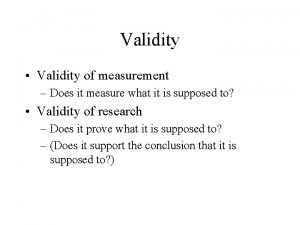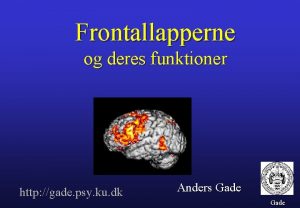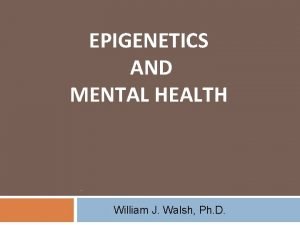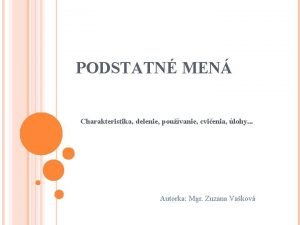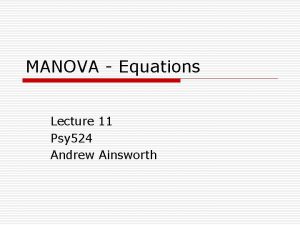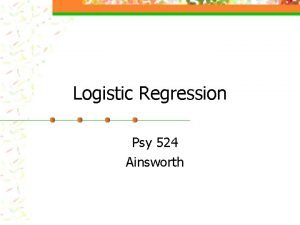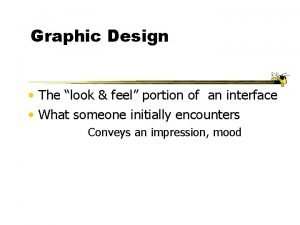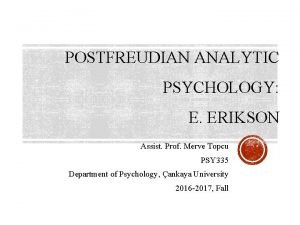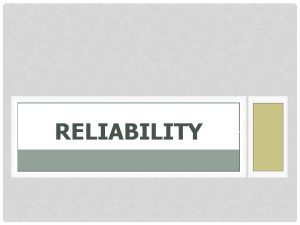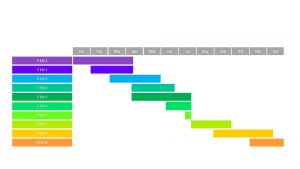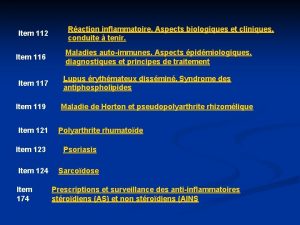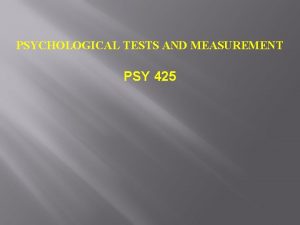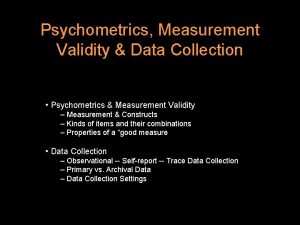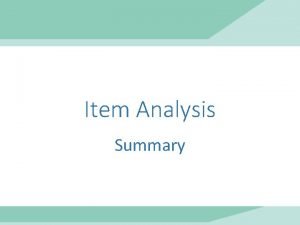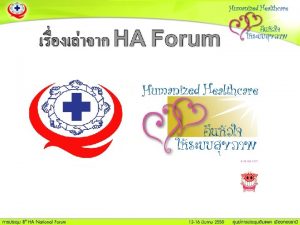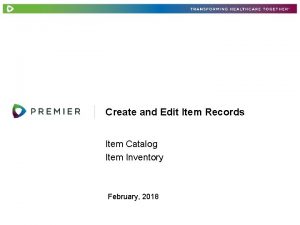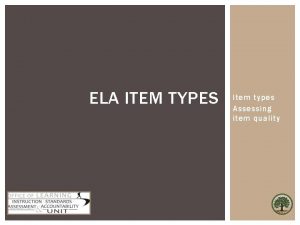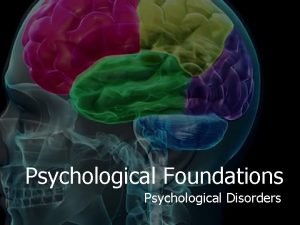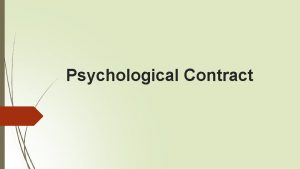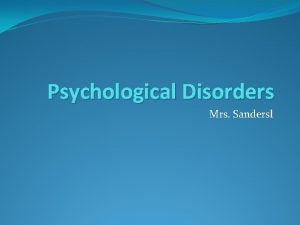Validity Item Analysis PSY 504 PSYCHOLOGICAL MEASUREMENT Validity
























- Slides: 24

Validity & Item Analysis PSY 504: PSYCHOLOGICAL MEASUREMENT

Validity Concerns what the instrument measures and how well it does that task Not something an instrument has or does not have The instrument is not validated… it is the uses of the instrument that are validated Informs counselor when it is appropriate to use the instrument and what can be inferred from the results Reliability is a prerequisite for validity

Movement Away from Traditional Categories of Validity Traditional types of validity Content-Related – the degree to which the evidence indicated that the items, questions, or tasks adequately represent the intended behavior domain Criterion-Related – the extent to which an instrument was systematically related to an outcome criterion (i. e. , is it a good predictor? ) Construct-Related – the extent to which the instrument may measure a theoretical or hypothetical construct or trait Face Validity – not really validity; refers to whether the test “looks valid” based on the content/questions

Validation Evidence Related to what was previously categorized as construct validity with an emphasis on the techniques used in the scientific method The accumulation of evidence is evaluated to determine an instrument’s construct validity Validation is a shared responsibility among the developers of the instrument and the practitioner

Evidence Based on Instrument (Test) Content Related to the traditional term content validity The degree to which the evidence indicates the items, questions, or tasks adequately represent the intended behavior domain (or construct) Central focus is typically on how the instrument’s content was determined Content-related validation evidence should not be confused with face validity

Evidence Based on the Response Processes Concerns whether individuals either perform or respond in a manner that corresponds to the construct being measured – information processing Can examine the response processes used by different groups Computer simulated performances to compare performance to the model-based answers produced by the computer

Evidence Based on Internal Structure Examine whether the items in one subscale are related to other items on that subscale Done by examining the internal structure of the instrument Factor Analysis – statistical technique used to analyze the interrelationships of a set or sets of data Can study the internal structure of an assessment with different groups (e. g. , gender, race or ethnicity)

Evidence Based on Relations to Other Variables Correlational method Convergent evidence/Discriminant evidence Prediction or instrument-criterion relationship Concurrent and predictive validity Regression Decision Theory Validity Generalization (Evidence-Based on Consequences of testing)

Correlational Method Correlational method – examines the relationship between an instrument and other pertinent variables or a criterion The performance on the instrument is correlated with the criterion information, which results in a validity coefficient Validity coefficients from different instruments can be compared Validity coefficients also allow for examining the amount of shared variance between the instrument and pertinent variables

Correlational Method Can also compare an instrument with another instrument Convergent evidence – an instrument is related to other variables to which it should theoretically be positively related Discriminant evidence – an instrument is not correlated with variables from which it should differ

Prediction or Instrument. Criterion Relationship Sometimes want an instrument that predicts future behavior (associated with the traditional criterion-related validity) Concurrent Validity – there is no time lag (relatively speaking) between when the instrument is given and when the criterion information is gathered Used for “immediate prediction” Predictive Validity – there is a time lag between when the instrument is administered and the time the criterion information is gathered

Prediction or Instrument. Criterion Relationship Regression – often used to determine the usefulness of a variable, or a set of variables, in predicting another important or meaningful variable (closely related to correlation) Based on the premise that a straight line – a regression line – can describe the relationship between the instrument’s scores and the criterion The regression line, or line of best fit, allows for predicting performance on the criterion based on scores on the instrument Y’ is the predicted score; a is the y-intercept; b is the slope; X is the score on the instrument

Prediction or Instrument. Criterion Relationship Regression Line

Prediction or Instrument. Criterion Relationship Comparing three instruments with a regression line

Prediction or Instrument. Criterion Relationship Standard Error of Estimate – indicates the margin of expected error in an individual’s predicted criterion score as a result of imperfect validity Sy = standard deviation of the criterion rxy = validity coefficient (which is then squared) Typically used to look at error around a cutoff point

Prediction or Instrument. Criterion Relationship Decision Theory – evaluates the accuracy of the decision making of an instrument based upon the relationship between the instrument and a criterion or predictor variable Often done through expectancy tables How often is the instrument is right (hit) and how often the instrument is wrong (miss) Helps in determining cutoff scores False Positives – instrument predicts the individuals have “it” (the criterion) when in fact they do not False Negatives – the instrument predicts the individuals do not have “it” when in fact they do

Prediction or Instrument. Criterion Relationship �Expectancy tables with false negatives and false positives Misses Hits Misses False -’s False +’s

Validity Generalization A method of combining validation studies to determine if the validity evidence can be generalized Must be a substantial number of studies Meta-analysis

Evidence-Based Consequences of Testing Must consider consequences when using an instrument (e. g. , racial/ethnic group differences) Group differences on tests used for employment selection Group differences in placement in special education Consider social implications when examining the validation evidence Ethical responsibility to consider what is in the client’s best interest

Conclusion on Validation Evidence Validity of an instrument is based on the gradual accumulation of evidence Counselor must evaluate the information to determine if it appropriate for which client under what circumstance Validation evidence should also be considered in informal assessments

Item Analysis - focus is on examining and evaluating each item on an instrument Item Difficulty – proportion of people getting an item correct (technically shows how easy the item is) p = # who answered correctly total number Item Discrimination – provides an indication of the degree to which an item correctly differentiates among the examinees on the behavior domain of interest Examinees are divided into two groups based on high/low scores Then subtract the proportion in the lower group from the proportion in the upper group who got the item correct: d = upper % - lower % (for normal distribution: use upper 27% and lower 27%) +1. 00 = all upper group correct; none lower group correct -1. 00 = none upper group correct; all lower group correct

Item Response Theory (Latent Trait Theory) Item Response Theory – focus is on each item and on establishing items that measure the individual’s ability or level of a latent trait Involves examining the item characteristic function (or item characteristic curve) and the calibration of each individual item – slanted “S curve” is often desired Parameters: Difficulty – typically looking for a correct response of 0. 50 Slope – typically steeper slopes indicate the item is a good discriminator; flat slopes are not good discriminators Basal level – an estimate of the probability that a person at the low end of the trait or ability scale will answer correctly (“probability of guessing”) Item response approach is not dependent on a norming group (SEM will differ across scores)

Item Response Theory (Latent Trait Theory) Item characteristic curves

Item Response Theory (Latent Trait Theory)
 Criterion validity vs predictive validity
Criterion validity vs predictive validity Metaphor adalah
Metaphor adalah Validity of measurement
Validity of measurement Euro psy
Euro psy Ucf psi chi
Ucf psi chi Psy2055
Psy2055 Psy 2055
Psy 2055 Psy2055
Psy2055 Psy
Psy Psy sanin
Psy sanin Psy
Psy Psy
Psy Phonological loop
Phonological loop Psy
Psy Psy 226
Psy 226 When sam listens to his girlfriend susan in the restaurant
When sam listens to his girlfriend susan in the restaurant Alla kulikova
Alla kulikova Psy ku
Psy ku Psy walsh
Psy walsh Polovnicke psy
Polovnicke psy Gramaticke kategorie
Gramaticke kategorie 11 psy
11 psy Regression psy
Regression psy Psy
Psy Psy 335 purdue
Psy 335 purdue


